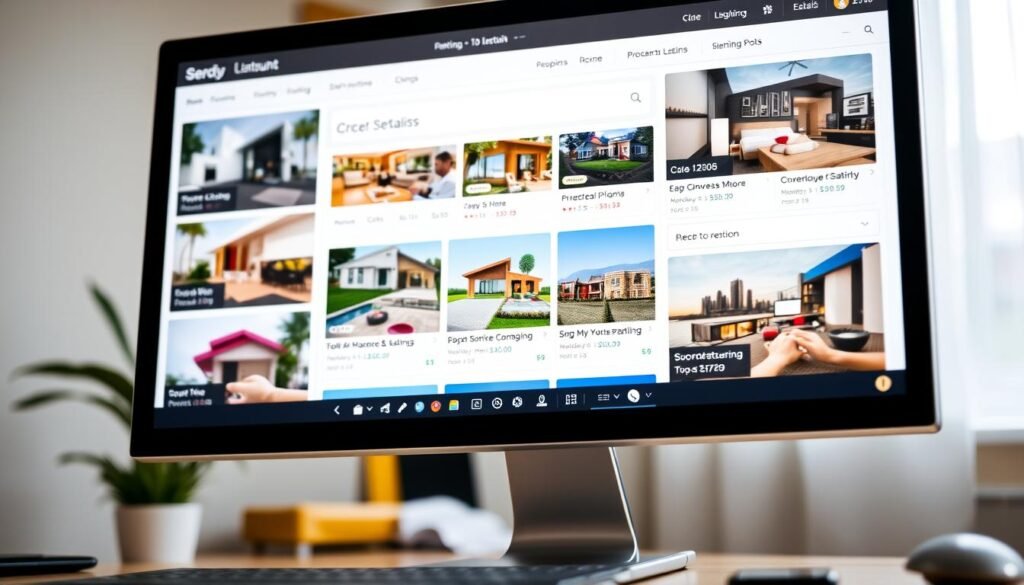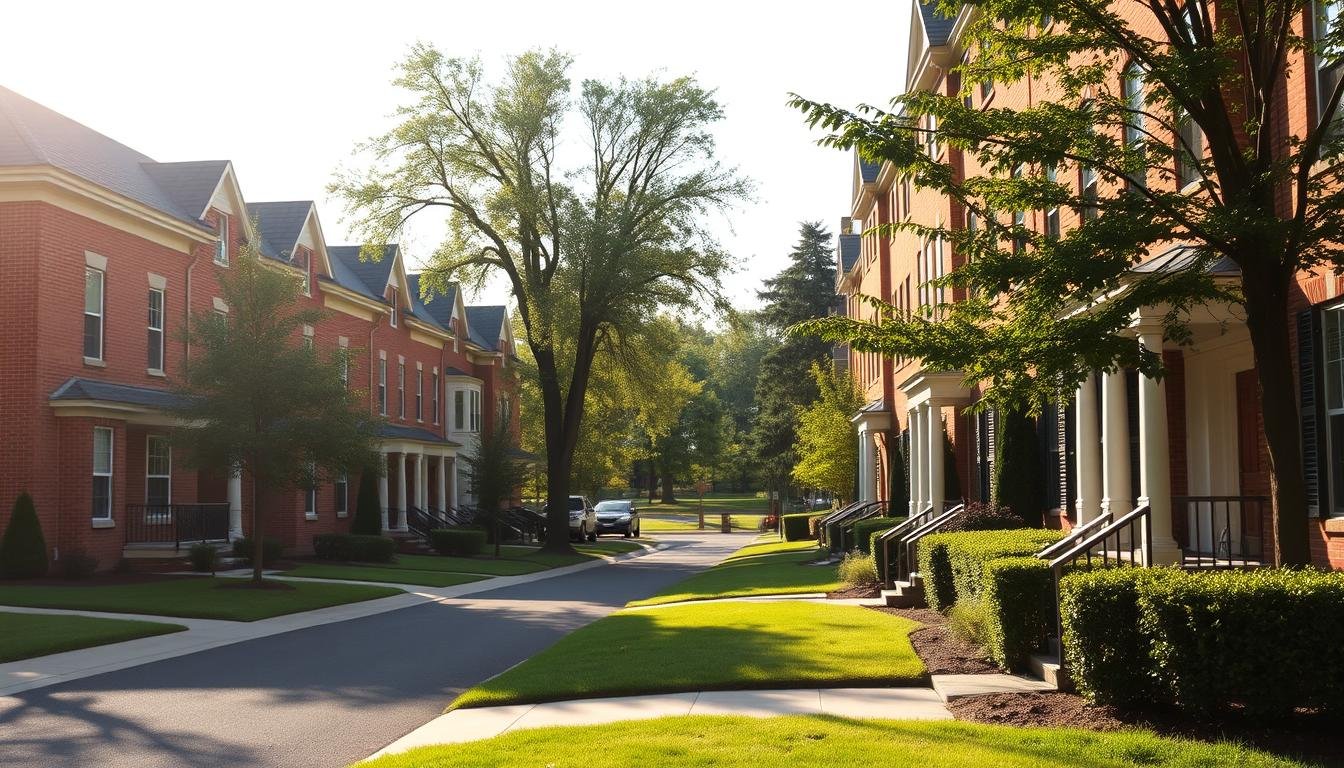Did you know that investing in rental homes can generate a steady stream of passive income? It also builds wealth over time. The right real estate rentals offer monthly cash flow from rent payments. They also appreciate in value over the long term.
Finding the perfect rental property requires careful consideration. You must understand your rental needs, research neighborhoods, and navigate lease agreements. By following expert tips and guidelines, you can find the ideal rental home. It should meet your lifestyle and investment goals.
Key Takeaways
- Understand your rental needs and priorities
- Research neighborhoods and local real estate trends
- Carefully review lease agreements before signing
- Consider factors like property management and maintenance costs
- Evaluate the long-term appreciation in property value
Understanding Your Rental Needs and Budget
Before starting your search for a rental property, it’s essential to evaluate your space needs and financial limits. Knowing your requirements and budget helps streamline your search. This ensures you find a property that aligns with your lifestyle and financial situation.
Assessing Your Space Requirements
Calculating your space needs involves determining the square footage you require. It also involves considering the layout of rooms.
Calculating Square Footage Needs
The size of the rental property you need depends on several factors. These include the number of occupants and your lifestyle. For instance, a single person might find a studio or one-bedroom apartment sufficient. On the other hand, a family would require more space.
- Consider the number of bedrooms and bathrooms you need.
- Think about the space required for living areas and storage.
- Assess whether you need additional spaces like a home office or play area.
Room Configuration Considerations
The layout of the rental property is as important as its size. Consider how the rooms are arranged and whether they meet your needs.
- Evaluate the flow of the living space.
- Consider the natural lighting and ventilation.
- Think about the privacy offered by the room configuration.
Setting a Realistic Budget
Setting a budget involves more than just determining how much rent you can afford. It includes understanding the 30% income rule and accounting for additional costs associated with renting a property.
The 30% Income Rule
A common guideline is that rent should not exceed 30% of your gross income. This rule helps ensure you have enough money for other expenses.
Example Budget Breakdown:
| Income Percentage | Expense Category | Sample Amount |
|---|---|---|
| 30% | Rent | $1,500 |
| 10% | Utilities | $500 |
| 5% | Other Expenses | $250 |
Accounting for Additional Costs
Beyond rent, there are other costs to consider. These include utilities, internet, and potentially renter’s insurance.
- Research the average cost of utilities for the area.
- Factor in the cost of internet and other services.
- Consider whether renter’s insurance is required or recommended.
Prioritizing Your Must-Have Features
Once you have a clear understanding of your space needs and budget, prioritize the features that are must-haves for you in a rental property.
For example, you might prioritize:
- Proximity to public transportation.
- In-unit laundry facilities.
- A pet-friendly environment.
By understanding your rental needs and budget, you can efficiently navigate the rental market. This ensures you find a property that meets your requirements.
Researching Potencial Neighborhoods
The neighborhood you choose can significantly impact your quality of life, making it essential to research areas thoroughly. Location is a critical factor that determines the types of tenants you attract and your vacancy rate.
Evaluating Safety and Crime Statistics
When researching neighborhoods, safety is a primary concern. Crime statistics provide valuable insights into an area’s safety. Online resources like crime maps can help understand common crimes in the area.
Key statistics to consider:
- Overall crime rate
- Types of crimes (violent, property, etc.)
- Crime rate trends over time
Proximity to Work, Schools, and Amenities
The proximity of a neighborhood to essential services and amenities is another critical factor. This includes commute times to work, schools, grocery stores, and other services you frequently use.
Calculating Commute Times
Understanding commute times is essential for assessing a neighborhood’s convenience. Online mapping tools can help calculate average commute times to work, schools, and other destinations.
Mapping Essential Services
Mapping essential services like grocery stores, pharmacies, and restaurants is also important. A neighborhood with a good balance of services can enhance your living experience.
| Service | Distance | Average Commute Time |
|---|---|---|
| Grocery Store | 1 mile | 15 minutes walking |
| Workplace | 5 miles | 30 minutes by car |
| School | 2 miles | 10 minutes by bike |
Understanding Neighborhood Character and Culture
The character and culture of a neighborhood can significantly impact your living experience. Researching the local culture, community events, and atmosphere can help determine if the neighborhood is a good fit for you.
“The neighborhood is the first thing people see when they step out of their front door, and it sets the tone for their entire living experience.”
By thoroughly researching neighborhoods, you can make an informed decision that meets your needs and enhances your quality of life.
Exploring Different Types of Rental Properties
Rental properties offer a wide range of options, catering to various lifestyles and budgets. Each type of property has its unique benefits, making it easier for renters to find the perfect match.
Apartments vs. Single-Family Homes
Apartments and single-family homes are the most common rental options. Apartments provide convenience and often include amenities like gyms and pools. Single-family homes, on the other hand, offer more space and privacy, ideal for families or those seeking solitude.
Choosing between an apartment and a single-family home depends on your budget, lifestyle, and preferences. For instance, if you have pets, a single-family home might be better due to the yard.
Condos and Townhouses
Condos and townhouses are also popular choices. Condos offer shared amenities and exterior maintenance by the association. Townhouses provide more space than apartments and feel more like a home.
Both condos and townhouses offer a balance of space and amenities. It’s important to review the rental agreement and understand any fees or restrictions.
Unique Rental Options
There are also unique rental options beyond traditional apartments and homes. Tiny homes, ADUs, and co-living spaces offer distinct advantages.
Tiny Homes and ADUs
Tiny homes are compact and affordable. ADUs, like backyard cottages or garage apartments, offer simplicity and cost savings. Both are great for those seeking efficiency.
Co-living Spaces
Co-living spaces focus on community. They feature shared living areas and amenities, creating a collaborative environment. Co-living is perfect for those who value community and convenience.
| Type of Rental Property | Key Features | Ideal For |
|---|---|---|
| Apartments | Centralized location, amenities like gym or pool | Urban dwellers, those who prefer convenience |
| Single-Family Homes | More space, privacy, potentially a yard | Families, pet owners |
| Condos and Townhouses | Shared amenities, multi-level living | Those seeking balance between space and amenities |
| Tiny Homes and ADUs | Compact, efficient, affordable | Simplistic living, budget-conscious renters |
| Co-living Spaces | Shared living areas, community-focused | Those who value community and convenience |
Utilizing Online Rental Listings Effectively
The search for the perfect rental property often starts with a click on online listings. Prospective tenants can explore a wide range of properties on various websites and apps. They can filter their search based on specific preferences.
Top Rental Websites and Apps
Investors often start their search on sites like Zillow, Trulia, Redfin, and Realtor.com. These platforms offer a vast database of rental properties. Each listing includes photos, descriptions, and essential details like rent, amenities, and location.
As noted by
“The rise of online rental platforms has significantly changed the way people search for homes, making it easier to compare properties and find the best fit.”
Decoding Listing Terminology
Understanding rental listing terminology is key to a successful search. It’s important to know common abbreviations and phrases used to describe properties.
Understanding Rental Abbreviations
Rental listings use abbreviations to convey information quickly. For example, “2BR/1BA” indicates a two-bedroom, one-bathroom apartment. Knowing these abbreviations helps quickly understand a property’s key features.
Reading Between the Lines
It’s also important to interpret beyond the literal meaning of the listing. Phrases like “charming” or “cozy” might suggest a smaller space. “Modern amenities” could indicate a newer building. Grasping these subtleties helps identify properties that align with one’s preferences.
Setting Up Alerts for New Listings
To stay competitive in the rental market, setting up alerts for new listings is strategic. Most rental websites and apps allow users to create accounts and set up notifications. This way, users can be among the first to know about new properties that match their criteria.

By effectively using online rental listings, prospective tenants can streamline their search. This approach saves time and increases the chances of finding the ideal rental property.
Working with Property Management Services
Managing a rental property can be overwhelming, leading many owners to seek property management services. These services aim to streamline property management, ensuring upkeep, timely rent collection, and compliance with laws.
Advantages of Hiring Professionals
Hiring a property management service offers significant advantages. Professionals bring deep knowledge in rental property maintenance, tenant screening, and local laws. This expertise minimizes legal risks and boosts profitability.
Property management services also save landlords a lot of time. Tasks like rent collection, maintenance requests, and tenant issues can be time-consuming. Outsourcing these duties allows landlords to focus on other important areas.
Key Questions for Property Managers
Choosing the right property management service requires asking the right questions. Key inquiries include:
- What experience do you have in managing properties similar to mine?
- How do you handle tenant screening and what criteria do you use to select tenants?
- What is your process for handling maintenance requests and emergencies?
- How do you manage rent collection and what are your policies on late payments?
Understanding the Costs and Services
Property management services charge a fee, often a percentage of monthly rent or a flat rate. It’s vital to know what services are included and any additional costs. Extra fees might apply for lease renewals, evictions, or property inspections.
By weighing the benefits and costs of property management services, landlords can make an informed choice. This decision greatly affects the property’s profitability and the owner’s stress levels.
Touring and Evaluating Rental Homes
Visiting rental homes in person is key to making a smart choice. When you spot a promising property, it’s vital to see it up close. This way, you can judge its condition and if it fits your needs.
Creating a Property Viewing Checklist
Before you begin, make a checklist to catch all important details. It should cover both inside and outside the property.
Interior Inspection Points
- Look for any damage or needed fixes on walls, floors, and ceilings.
- Check the plumbing and appliances to ensure they work well.
- Test the electrical outlets and lights for any problems.
- Assess the cleanliness and upkeep of the property.
Exterior and Common Area Assessment
- Examine the building’s exterior, including the roof and gutters.
- Inspect common areas like laundry rooms, gyms, or community spaces.
- Check out parking and storage if available.
- Observe the neighborhood for noise levels, amenities, and safety.
A National Association of Realtors survey found that nearly 9 out of 10 buyers and renters value the neighborhood highly.
“The neighborhood is just as important as the property itself. Pay attention to the surroundings and local amenities.” –
Red Flags to Watch For During Tours
Be on the lookout for signs of possible problems during your visit. These could turn into costly issues later.
| Red Flag | Potential Issue |
|---|---|
| Water stains or leaks | Roof or plumbing issues |
| Cracks in walls or ceilings | Structural damage or settlement issues |
| Outdated electrical systems | Safety hazards and possible electrical fires |
Taking Effective Notes and Photos
It’s important to document your findings. This helps you compare properties and make a choice.
- Take clear, well-lit photos of each room and notable features.
- Make detailed notes on the condition and any issues observed.
- Record the date and time of your visit, as well as any interactions with the landlord or property manager.
By following these steps, you can thoroughly evaluate rental homes. This ensures you make a choice that fits your needs and budget.
Understanding Lease Agreements and Terms
Before you sign, it’s critical to grasp your lease agreement fully. A lease agreement is a legally binding contract between you and your landlord. It outlines the terms of your rental arrangement.
Common Lease Clauses Explained
Lease agreements have various clauses that set the rules for your tenancy. Key clauses include rent payment terms, lease duration, and responsibilities for maintenance and repairs. It’s essential to understand these clauses to avoid disputes or penalties.
- Rent payment terms: Details on how and when to pay rent.
- Lease duration: Specifies the length of your tenancy.
- Maintenance responsibilities: Outlines who is responsible for maintenance and repairs.
Negotiating Favorable Terms
While lease agreements are often seen as non-negotiable, there are times you can negotiate terms. Identify areas open to negotiation, such as lease length or pet policies.
Lease Length Considerations
The lease length can greatly affect your rental experience. A longer lease offers stability, while a shorter lease provides more flexibility. Think about your future plans and financial situation when choosing a lease length.
Pet and Modification Policies
Understanding pet and modification policies is key if you have pets or plan to make changes. Some landlords have strict policies, so it’s important to clarify these before signing.
| Policy | Description | Impact |
|---|---|---|
| Pet Policy | Specifies if pets are allowed and any associated fees. | Affects pet owners; may include additional costs. |
| Modification Policy | Outlines what changes you can make to the property. | Impacts your ability to customize your living space. |
Understanding Your Rights as a Tenant
As a tenant, you have rights protected by law. These include the right to a habitable living environment and protection against unfair practices. Knowing local tenant laws ensures you’re treated fairly.
Preparing a Strong Rental Application
Unlocking your dream rental property starts with a solid rental application. A well-crafted application highlights your reliability and distinguishes you from others.

Essential Documents for Rental Applications
Gathering all necessary documents is the first step. These include:
- Proof of income, such as pay stubs or an employment letter
- Identification documents, like a driver’s license or passport
- Rental history, including previous landlord references
- Credit reports or scores, if available
Having these documents ready shows your organization and commitment to renting the property.
Building a Positive Rental History
A positive rental history can greatly enhance your application. This involves:
- Paying rent on time
- Maintaining the rental property
- Providing adequate notice when moving out
Building a strong rental history requires time but is invaluable for future opportunities.
Addressing Credit or Reference Concerns
Addressing credit issues or concerns about your rental references is critical.
Explaining Past Credit Issues
If you’ve faced credit problems, be ready to explain them. This could be due to unforeseen medical expenses, job loss, or other valid reasons. Providing context can help alleviate concerns.
Using Co-signers Effectively
Consider using a co-signer if credit issues are significant. A co-signer with good credit can reassure the landlord. Make sure your co-signer understands their responsibilities and the lease terms.
By addressing concerns early and presenting a detailed rental application, you can improve your chances of securing your desired rental property.
Navigating the Tenant Screening Process
Landlords employ the tenant screening process to assess the reliability and creditworthiness of prospective tenants. This step is vital for both parties, ensuring a legally compliant and smooth rental experience.
What Landlords Look For in Tenants
Landlords seek tenants with stable incomes, positive rental histories, and satisfactory credit scores. They also consider employment status, previous landlord references, and any past evictions or bankruptcies.
Key factors landlords consider include:
- Rental history and previous landlord references
- Credit score and history
- Employment status and income stability
- Any past evictions or legal issues related to rental properties
Preparing for Background and Credit Checks
To prepare for background and credit checks, prospective tenants should ensure their credit reports are accurate and up-to-date. They should also be ready to provide documentation such as proof of income, employment verification, and identification.
Tips for preparing for background and credit checks:
- Check your credit report for errors
- Gather necessary documents like pay stubs and identification
- Be transparent about your rental history
Providing Strong References
Providing strong references from previous landlords can significantly enhance a tenant’s application. Tenants should maintain a good relationship with their previous landlords and ask for their consent before listing them as references.
Best practices for providing strong references:
- Choose previous landlords who can vouch for your reliability
- Ensure your references are aware they may be contacted
- Provide their contact information accurately
Managing Rental Property Maintenance
Rental property maintenance goes beyond just fixing things when they break. It involves proactive care to ensure the property’s longevity and livability. Effective maintenance is key to preserving property value and tenant satisfaction.

Understanding Maintenance Responsibilities
It’s essential to know who is responsible for what in rental property maintenance. This clarity prevents misunderstandings and ensures the property remains well-maintained.
Tenant vs. Landlord Obligations
Landlords are usually responsible for the property’s structural integrity, including the roof, walls, and foundation. They must also ensure plumbing and heating systems work properly. Tenants, on the other hand, are responsible for keeping the property clean and in general good condition.
Documenting Property Condition
It’s vital to document the property’s condition at the start and end of tenancies. Detailed reports and photographs help resolve disputes over damages or needed repairs.
Creating a Maintenance Request System
A well-organized maintenance request system is critical for efficient property management. It should allow tenants to report maintenance issues easily and enable landlords or property managers to track and address these requests promptly.
- Implement an online portal or a dedicated phone line for maintenance requests.
- Establish a clear protocol for handling emergency situations.
- Keep a record of all maintenance requests and the actions taken.
Emergency Maintenance Situations
Some maintenance issues, like a burst pipe or heating failure in winter, are emergencies that need immediate attention. Having a plan for such situations is essential.
Preparing for Emergencies: Landlords should have a list of reliable contractors ready to respond quickly. Tenants should know who to contact in emergencies and what steps to take to minimize damage.
Conclusion: Securing Your Ideal Rental Property
Finding the perfect rental property is a journey that demands patience, persistence, and the right guidance. This guide has provided you with a detailed understanding of navigating the rental market. You now know how to effectively search for your ideal home.
Key takeaways from our discussion include understanding your rental needs and budget, researching neighborhoods, and exploring different types of properties. Using online rental listings and working with property management services can also help streamline your search.
Experts in the field highlight that “the right rental property can significantly enhance your quality of life.” This emphasizes the need to take your time and be thorough in your search.
To recap, securing your ideal rental property involves several key steps:
- Assessing your space requirements and setting a realistic budget
- Researching neighborhoods for safety, proximity to amenities, and character
- Understanding lease agreements and terms
- Preparing a strong rental application
By meticulously following these steps, you can increase your chances of finding a rental property that meets your needs and enhances your living experience.
“The perfect rental property is out there; it’s about being prepared to find it.”
As you move forward, remember that securing the right rental property is not just about finding a place to live. It’s about creating a home that suits your lifestyle and needs.
Sources
For more information on rental properties and related topics, you can refer to the following credible sources:
- Zillow Rentals – A detailed resource for real estate rentals, including listings and market trends.
- Apartment List – A platform that helps you find rental properties, with detailed listings and neighborhood information.
- Nolo Property Management – Offers guidance on property management services, including legal aspects and best practices.
- Investopedia – Provides financial insights and tips for finding and managing rental properties.
These resources can help you navigate the process of finding and managing rental properties. They ensure you make informed decisions in the real estate rentals market.
FAQ
What is the 30% income rule in rental budgeting?
The 30% income rule advises renters to keep their rent below 30% of their gross income. This helps prevent financial hardship.
How do I evaluate the safety of a neighborhood?
To assess a neighborhood’s safety, start by researching crime statistics online. Next, visit the area at various times. Also, speak with locals or law enforcement for their insights.
What are the benefits of working with property management services?
Property management services simplify the rental process. They handle tasks like rent collection, maintenance, and tenant screening. This makes owning rental property less stressful.
What should I look for when touring a rental home?
When viewing a rental, look for maintenance issues and assess the overall condition. Consider factors like natural light and storage space as well.
How can I effectively utilize online rental listings?
To make the most of online listings, use top rental websites and apps. Understand the terminology and set up alerts for listings that fit your criteria.
What are common lease clauses that I should be aware of?
Key lease clauses include the rent amount, lease duration, security deposit, and maintenance and repair responsibilities.
How can I prepare for the tenant screening process?
Prepare for tenant screening by gathering necessary documents and ensuring a positive rental history. Be ready for background and credit checks.
What are my responsibilities regarding rental property maintenance?
As a tenant, you’re responsible for reporting maintenance issues, keeping the property clean, and following your lease agreement.
How do I negotiate favorable terms in a lease agreement?
To negotiate better terms, research the local rental market and clearly state your needs. Be open to compromise on some points.
What should I consider when evaluating different types of rental properties?
When comparing rental properties, think about your space needs, budget, and preferred community or neighborhood.
